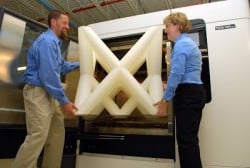Stratasys’ Fortus 900mc is the largest, most accurate 3D printer in the company’s Performance line-up.
The Fortus 900 is capable of building anything from large prototypes to short-run production volumes thanks to one of the largest build volumes of all plastic additive manufacturing machines.
Aside from its large build volume, the Fortus 900mc is also supported by Stratasys’ full complement of thermoplastics. Whether a project requires prototype caliber ABS or high-strength Nylon-12, the 900 can process materials to fit almost any design need. It would be nice if the machine were able to use generic materials, but at this time the materials the 900mc uses are all proprietary to Stratasys.
As for quality, the 900 is a quantum leap ahead of other Fused Deposition Modelling (FDM) printers. Stratasys has seen to it that the Fortus 900mc contains significant upgrades to its mechanical components and well as its electron mechanical and electric systems. When combined together these upgrades result in higher print resolutions, greater throughput, better repeatability and enhanced material use, although the system is still limited by the underlying FDM technology.
How the Fortus 900mc Works:
Similar to other FDM machines, the 900 builds models by extruding either a thermoplastic or support material onto a flat, exchangeable print board housed within a heated print chamber. At the beginning of a print, several layers of support material are extruded in the shape of the model being printed. These layers form a base that make removing the models from the board much easier once the print is done.
After printing the support base the 900mc will begin printing its model from whichever material is selected. Wherever support material is needed the 900mc will switch from its “model” material to support material to ensure that a print is mechanically sound.
Once a print has finished, it can be removed from its print base and support material can be broken away from the model. If support material remains on the model it can be placed inside a chemical bath where it will dissolve over the course of several hours.
Read more at ENGINEERING.com


